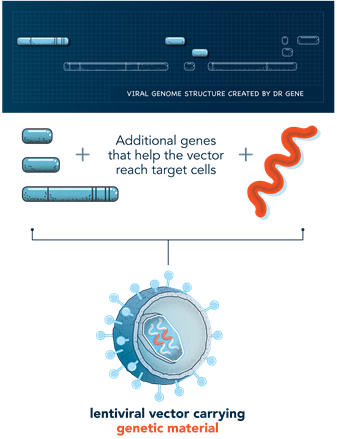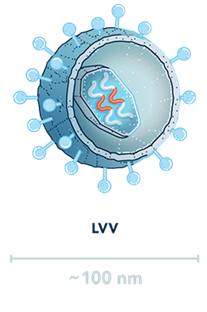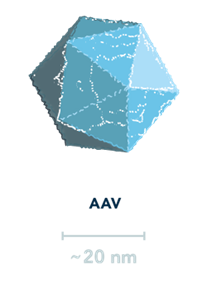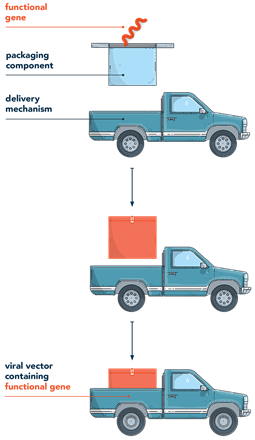
What is a vector?
Gene therapy works by introducing genetic material (such as a transgene or nuclease) into the nucleus of the cell. The system used to deliver genetic material is known as a vector. Think of a vector as a microscopic delivery truck that transports packages (genetic material) to specific locations (target cells).
There are two types of vectors, viral and non-viral. Viral vectors are currently a delivery vehicle used in FDA-approved gene therapies. Non-viral techniques are currently being studied as a safe and effective way to deliver genetic material to cells for therapeutic effect.
Gene therapy works by introducing genetic material (such as a transgene or nuclease) into the nucleus of the cell. The system used to deliver genetic material is known as a vector. Think of a vector as a microscopic delivery truck that transports packages (genetic material) to specific locations (target cells).
There are two types of vectors, viral and non-viral. Viral vectors are currently a delivery vehicle used in FDA-approved gene therapies. Non-viral techniques are currently being studied as a safe and effective way to deliver genetic material to cells for therapeutic effect.
Gene therapy works by introducing genetic materialGenetic materialrefers to DNA or RNA that play a fundamental role in creating proteins critical to a cell’s structure or its function in the body
See glossary for more terms > (such as a transgeneTransgenea portion of DNA from one organism inserted into the genome of another organism
See glossary for more terms > or
nucleaseNucleasean enzyme that is capable of cleaving the bond between two bases in a nucleic acid at a specific sequence
See glossary for more terms >) into the nucleus of the cell. The system used to deliver genetic material is known as a vectorVectora delivery system used to introduce genetic material into the nucleus
See glossary for more terms >. Think of a vector as a microscopic delivery truck that transports packages (genetic material) to specific locations (target cells).1-4
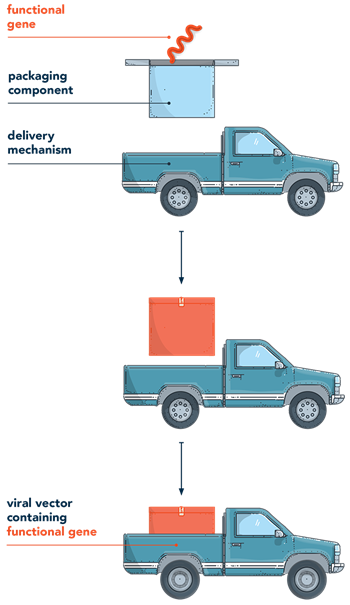
Types of vectors
There are 2 types of vectors: viralViral vectora way to deliver genetic material to a cell using the blueprint of a virus as a guide; it may be used to carry genes and change mutated cells to healthy ones
See glossary for more terms > and non-viralNon-viral vectora way to deliver genetic material to a cell that is not based on a virus
See glossary for more terms >. Each type of vector offers different methods of delivering genetic material into cells.1,3,5,6
- Non-viral vectors depend on physical or chemical methods of delivering genetic material into a cell. This can be either a physical technique (like a needle entering a cell) or a chemical technique (created in a lab). The most actively researched non-viral vectors include chemical disruptionChemical disruption vectora type of vector that is typically designed to target specific cells and increase the delivery of genetic material to cytosol or nucleus
See glossary for more terms >, electroporationElectroporationthe use of an electric field to make a cell more permeable, which allows the delivery of genetic material
See glossary for more terms >, and polymer-based vectorsPolymer-based vectorpolymers are one of the substances used to create chemical vectors. These complexes protect DNA and facilitate cell uptake and intracellular delivery
See glossary for more terms >. Non-viral techniques are actively being studied for their safety and efficacy (how well it works)5 - Viral vectors are built using a blueprint of a virus—not the actual virus itself. Scientists only use the parts of the blueprint of the virus that help with delivering genetic material. Currently, viral vectors are the most common vehicle used in FDA-approved gene therapies2
Why are viruses used to deliver gene therapy?
Viruses are used as models or blueprints to create viral vectors. This is because viruses are good at entering the nucleus and delivering instructions to a host cell—much like a delivery truck delivers packages to people. Scientists have actually mapped the complete genetic material (genome) of many viruses. They are able to isolate the helpful elements of a virus’ genome—the delivery truck components—and create them on their own as the starting point for a viral vector. To create a viral vector, only a few parts of the virus are used. These parts alone are not adequate to cause viral infection.
Viruses provide an ideal model for delivering gene therapy to a host cell—the target location where a researcher will want gene therapy to treat a genetic mutation. Because of a virus’ natural design, they are very effective at entering a cell—just like how a delivery truck knows the neighborhood streets so well that it can easily navigate to peoples’ homes and deliver their packages. Scientists have created blueprints, or mapped, the complete genomeGenomethe entire set of genetic instructions found in a cell nucleus
See glossary for more terms > (complete set of genes of an organism) of many viruses. They are able to isolate parts of the virus genome that are effective at entering cells while removing the parts of the virus genome that could cause a disease. Only a few, safe parts of the original virus blueprint are used, and these parts alone are not adequate to cause viral infection.2,3
While a number of viral blueprints exist, the choice of vector is based on characteristics such as duration of gene expressionGene expressionthe information encoded in a gene is used to direct the assembly of a protein molecule
See glossary for more terms >, the size of the genetic material is can deliver, target cells, and immunogenicityImmunogenicitythe degree to which a substance triggers an immune response
See glossary for more terms >.1
Once the vector reaches the target cell, it is able to:
- Pass through the cell membrane, enter the cell, and reach the nucleus2,3
- At the nucleus, it disassembles itself (the package is taken out of the delivery truck)2,3
- Delivers the genetic material (the package) into the nucleus2,3
Now in the nucleus, the genetic material instructs the cell to provide the desired treatment effect. The cell then naturally breaks down the vector and it’s disposed of by the body.7

Other topics you may be interested in:

Keep learning with Genehome
References
1. National Institutes of Health. Genetics Home Reference. Help me understand genetics. Accessed May 3, 2021. https://medlineplus.gov/download/genetics/understanding/primer.pdf 2. Thomas CE, Ehrhardt A, Kay MA. Progress and problems with the use of viral vectors for gene therapy. Nat Rev Genet. 2003;4(5):346-358. 3. STAT Reports. The STAT guide to viral vectors, the linchpin of gene therapy. STAT News; 2019. 4. FDA Commissioner. What is gene therapy? How does it work? US Food and Drug Administration. Accessed July 1, 2021. https://www.fda.gov/consumers/consumer-updates/what-gene-therapy-how-does-it-work 5. Al-Dosari MS, Goa X. Nonviral gene delivery: principle, limitations, and recent progress. AAPS J. 2009;11(4):671-681. 6. Kim TK, Eberwine JH. Mammalian cell transfection: the present and the future. Anal Bioanal Chem. 2010;397(8):3173-3178. 7. National Institutes of Health. Gene therapy. Talking glossary of genetic terms. Accessed July 1, 2021. https://www.genome.gov/genetics-glossary/Gene-Therapy 8. Watts JM, Dang KK, Gorelick RJ, et al. Architecture and secondary structure of an entire HIV-1 RNA genome. Nature. 2009;460(7256):711-716. 9. Wold WSM, Toth K. Adenovirus vectors for gene therapy, vaccination and cancer gene therapy. Curr Gene Ther. 2013;13(6):421-433. 10. Centers for Disease Control and Prevention. A New Study of Hemophilia Occurrence Finds Many More Cases in the United States. Accessed June 29, 2021. https://www.cdc.gov/ncbddd/hemophilia/features/keyfinding-hemophilia-occurrence-US.html 11. Sheridan C. Gene therapy finds its niche. Nat Biotechnol. 2011;29(2):121-128. 12. Warnock J, Daigre C, Al-Rubeai M. Introduction to viral vectors. In Merten O-W and Al-Rubeai M (eds). Viral vectors for gene therapy: methods and protocols, methods in molecular biology. Springer Science+Business Media; 2011. 13. Durand S, Cimarelli A. The inside out of lentiviral vectors. Viruses. 2011;3(2):132-159. 14. Escors D, Breckpot K. Lentiviral vectors in gene therapy: their current status and future potential. Arch Immunol Ther Exp. 2010;58(2):107-119. 15. Cavazzana-Calvo M, Payen E, Negre O, et al. Transfusion independence of HMGA2 activation after gene therapy of human beta-thalassaemia. Nature. 2010;467(7313):318-322. 16. Shaw A, Suzuki M. Immunology of adenoviral vectors in cancer therapy. Molecular Therapy. 2019;15:418-429. 17. Crystal R. Adenovirus: the first effective in vivo gene delivery vector. Human gene therapy. 2014;25:3-11. 18. Flotte T. Birth of a new therapeutic platform: 47 years of adeno-associated virus biology from virus discovery to licensed gene therapy. Molecular Therapy. 2013;21(11):1976-1981. 19. Vector Bioloabs. Choosing the right viral vector. https://www.vectorbiolabs.com/adenovirus-vs-aav/ Accessed June 23, 2021. 20. Gene therapy clinical trials worldwide. Journal of Gene Medicine. John Wiley and Sons, Ltd. 2019. https://a873679.fmphost.com/fmi/webd/GTCT. Accessed June 28, 2021. 21. Ramamoorth M, Narvekar A. Non viral vectors in gene therapy – an overview. J Clin Diagn Res. 2015;9(1):GE01-6. 22. Fernandes L. CRISPR to correct gene defect that causes sickle cell disease. UCSF. Accessed May 5, 2021. https://www.ucsf.edu/news/2021/03/420137/uc-consortium-launches-first-clinical-trial-using-crispr-correct-gene-defect 23. Arnold C. What’s new in clinical CRISPR? Nature Medicine. 2021;27:184-185. 24. Cullis P, Hope M. Lipid nanoparticle systems for enabling gene therapies. Molecular Therapy. 2017;25(7):1467-1475.

